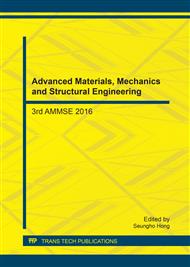[1]
J. Slock, D. vanRiet, D. Kolibachuk, E. P. Greenberg, Critical regions of the Vibrio fischeri LuxR protein defined by mutational analysis, J. Bacteriol. 172(7) (1990) 3974-3979.
DOI: 10.1128/jb.172.7.3974-3979.1990
Google Scholar
[2]
D. G. Davies, M. R. Parsek, J. P. Pearson, B. H. Iglewski, J. W. Costerton, E. P. Greenberg, The involvement of cell-to-cell signals in the development of a bacterial biofilm, Sci. 280(5361) (1998) 295-298.
DOI: 10.1126/science.280.5361.295
Google Scholar
[3]
M. Schuster, D. J. Sexton, S. P. Diggle, E. P. Greenberg, Acyl-homoserine lactone quorum sensing: From evolution to application, Annu. Rev. Microbiol. 67 (2013) 43-63.
DOI: 10.1146/annurev-micro-092412-155635
Google Scholar
[4]
B. L. Bassler, R. Losick, Bacterially speaking, Cell 125(2) (2006) 237-246.
DOI: 10.1016/j.cell.2006.04.001
Google Scholar
[5]
T. Bjarnsholt, M. Givskov, Quorum-sensing blockade as a strategy for enhancing host defences against bacterial pathogens, Phil. Trans. R. Soc. B 362(1483) (2007) 1213-1222.
DOI: 10.1098/rstb.2007.2046
Google Scholar
[6]
N. A. Whitehead, A. M. L. Barnard, H. Slater, N. J. L. Simpson, G. P. C. Salmond, Quorum sensing in gram-negative bacteria, FEMS Microbiol. Rev. 25(4) (2001) 365-404.
DOI: 10.1111/j.1574-6976.2001.tb00583.x
Google Scholar
[7]
E. P. Greenberg, Quorum sensing in gram-negative bacteria, ASM News 63 (1997) 317-377.
Google Scholar
[8]
Y. Takayama, E. Nasuno, K. Iimura, T. Morohoshi, N. Kato, Quartz crystal microbalance analyses of SpnR binding constants as a negative regulator of N-acylhomoserine lactone-dependent quorum sensing in Serratia marcescens AS-1, Chem. Lett. 44(7) (2015).
DOI: 10.1246/cl.150294
Google Scholar
[9]
Y. Takayama, N. Kato, In vitro analysis of essential binding sites on the promoter of the Serratia marcescens spn operon with the quorum-sensing receptor SpnR, Biotechnol. Bioeng. 113(11) (2016) 2513-2517.
DOI: 10.1002/bit.26013
Google Scholar
[10]
T. Morohoshi, K. Tokita, S. Ito, Y. Saito, S. Maeda, N. Kato, T. Ikeda, Inhibition of quorum sensing in gram-negative bacteria by alkylamine-modified cyclodextrins, J. Biosci. Bioeng. 116(2) (2013) 175-179.
DOI: 10.1016/j.jbiosc.2013.01.022
Google Scholar
[11]
N. Kato, T. Tanaka, S. Nakagawa, T. Morohoshi, K. Hiratani, T. Ikeda, Control of virulence factor expression in opportunistic pathogens using cyclodextrin immobilized gel, J. Incl. Phenom. Macrocycl. Chem. 57(1) (2007) 419-423.
DOI: 10.1007/s10847-006-9228-5
Google Scholar
[12]
C. Okano, E. Nasuno, K. Iimura, N. Kato, Cyclodextrin-immobilized microspheres for uptake of the quorum-sensing signaling molecule N-acylhomoserine lactone, J. Appl. Poly. Sci. 133(12) (2016) 43198.
DOI: 10.1002/app.43198
Google Scholar
[13]
H. Slater, M. Crow, L. Everson, G. P. C. Salmond, Phosphate availability regulates biosynthesis of two antibiotics, prodigiosin and carbapenem, in Serratia via both quorum-sensing-dependent and -independent pathways, Mol. Microbiol. 47 (2003).
DOI: 10.1046/j.1365-2958.2003.03295.x
Google Scholar
[14]
T. Morohoshi, T. Shiono, K. Takidouchi, M. Kato, N. Kato, J. Kato, T. Ikeda, Inhibition of quorum sensing in Serratia marcescens AS-1 by synthetic analogs of N-acylhomoserine lactone, Appl. Environ. Microbiol. 73(20) (2007) 6339-6344.
DOI: 10.1128/aem.00593-07
Google Scholar
[15]
C. Okano, M. Arai, E. Nasuno, K. Iimura, T. Morohoshi, T. Ikeda, N. Kato, β-Cyclodextrin interaction with N-hexanoyl homserine lactone as quorum sensing signal produced in gram-negative bacteria, Trans. Mat. Res. Soc. Jpn. 37(2) (2012) 315-318.
DOI: 10.14723/tmrsj.37.315
Google Scholar


